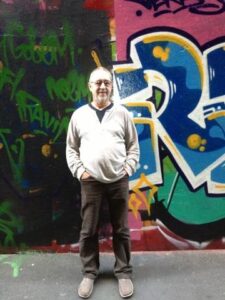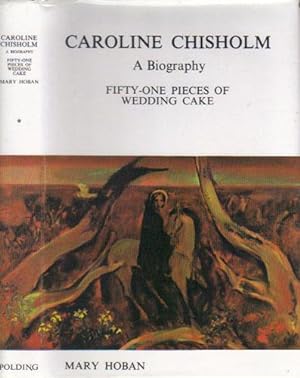by Bill Holloway
 In 1991, John Moran titled his collection of four Caroline Chisholm essays, Radical in Bonnet and Shawl, which I think gives an excellent sense of Chisholm’s activism in relation to the establishment of a family-based working class in Australia; and of her progressive views on race.
In 1991, John Moran titled his collection of four Caroline Chisholm essays, Radical in Bonnet and Shawl, which I think gives an excellent sense of Chisholm’s activism in relation to the establishment of a family-based working class in Australia; and of her progressive views on race.
When I first reviewed Mary Hoban’s Caroline Chisholm biography, Fifty-One Pieces of Wedding Cake (1973), some years ago, Prof. Marion Diamond commented: “I found the Caroline Chisholm in 51 Pieces a bit too domesticated for me! Maybe because at my girl’s school, we had 4 ‘houses’ – Chisholm, (Jane) Franklin,(Elizabeth) Macarthur and (Lucy) Osborne – all of them portrayed as ladylike and virtuous – just like we were meant to be 🙂.
I loved Caroline Chisholm’s more radical persona in her own speeches – especially when she went in to bat for the Chinese during the anti-Chinese frenzy on the goldfields. It hadn’t occurred to me before to link that back to her early years in multi-racial Madras.”
In Madras, as I wrote last week, the newly married Chisholms chose to live outside the walls of Fort St George, in Black Town, where Caroline had her school for the often mixed race daughters of British soldiers. “In this part of the city lived Indians, Eurasians and the poorer whites. The whites included English, Irish, Scots, French, Armenian and Jewish people. The Indians were both Hindus and Mohametans (the latter often called the ‘Moors’)”. (Hoban)
Then in 1838, after six years in India, the family which by then included two sons, sailed for New South Wales, on what was initially intended just to be a long furlough.
By that time, with transportation of convicts coming to an end, some large property owners were unready for the end of the master/slave relationship still prevailing throughout the empire. And although the reality has always been sugar-coated, convicts were slaves, at least until their terms could be shown to have been served; squatters, especially on cattle runs, demanded labour from the local Aboriginal people in return for rations and the “right’ to stay on their own land; and Queenslanders were bringing in slaves from the Pacific Islands.
 On the Chisholm’s ship out were “ten Indian coolies intended for an Australian employer… It was said among the passengers that the ten … must have been brought aboard after being given opium. They were entirely sick and miserable, and two of them ran away [when the ship called] at Mauritius. A third later died, demented with homesickness and fear”. Later they discover, “Some of the big men who had been officers in India … had been importing coolies to work for them. These were cheap enough – they could live on a bit of rice and oil and the smell of an onion, but they had no guts and dropped like flies.” (Hoban)
On the Chisholm’s ship out were “ten Indian coolies intended for an Australian employer… It was said among the passengers that the ten … must have been brought aboard after being given opium. They were entirely sick and miserable, and two of them ran away [when the ship called] at Mauritius. A third later died, demented with homesickness and fear”. Later they discover, “Some of the big men who had been officers in India … had been importing coolies to work for them. These were cheap enough – they could live on a bit of rice and oil and the smell of an onion, but they had no guts and dropped like flies.” (Hoban)
In 1841 the Governor responded to a petition in the SMH for the introduction of Indian labour with, “Call it in this Colony what we may, in England this petition will be called an application for slave labour.”
The (white) census of the same year showed that the ratio of men to women was 10:1, in a population of 43,000. Mrs Chisholm’s concern was that outside Sydney, where the ratio was of course even higher, single men were taking Aboriginal women. She wrote a couple of years later – about female Immigration – “If the happiness of her own children does not induce England to adopt prompt measures to secure this blessing to the Colony, the gradual destruction and extermination of the Aborigines DEMAND it from her justice!!!”.
(Interestingly, and not related to Caroline Chisholm, one of the concerns of NSW property owners at the time was to reduce the number of poor Catholic migrants from Ireland, whom they perceived as anti-British).
Mrs Chisholm demanded proper receiving facilities for unaccompanied working class women firstly to save them from prostitution; and then to work towards reducing the almost total reliance in the bush on single men. She wrote: “From [my first visit to the wharves] I devoted all my leisure time in endeavouring to serve these poor girls, and felt determined, with God’s blessing, never to rest until decent protection was afforded them. In January, 1841, I wrote to Lady Gipps, and from that time I never ceased in my exertions. I knew that every ship’s arrival would increase the necessity for such an institution.” (Mackenzie)
An article in the Illustrated London News – reprinted widely in Australia – in 1852, described her work thus:






Radical in Bonnet and Shawl *is* a good title. I also like the cover of the biography. Her capacity for nuance and compassion are evident in that long quotation about Chinese migrants.
I have that edition pictured.
“The dust cover is a reproduction of Melbourne artist, Benard Lawson’s large oil painting, showing Caroline Chisholm, on her white horse, moving through a harsh Australian landscape. The serenity of the central figure contrasts with the threatening background. Does one recall Pilgrim’s Progress? a medieval knight? a stained glass window?”
I glad Dr Diamond, now long retired from blogging, prompted me to look at Chisholm’s later career and her campaigning for civil rights for Chinese in particular.
What a woman Bill. Thanks for all this — love her absolute understanding of humanity, and her putting her money where her mouth is, it seems.
BTW Diamond’s comment on your past review, reminded me of my own (government) girls’ school houses. I was in Turner, named for who know whom. All our houses were named for women, but not all well known like Chisholm and Franklin. I don’t recollect the focus being on “being ladylike and virtuous”. There was an element of that in our dress code etc but I never felt that was the over-riding expectation at all. I looked up the houses on the school’s website, and this is what they say “The five women were chosen [in 1934] as house patrons because of their outstanding contributions to the fields of medicine, social science, art literature and education. In these fields they were all leaders and therefore their names carry inspiration.”
Sue, I’m sorry to be three months late (I was going over old posts making sure I wasn’t repeating myself). I think Caroline Chisholm, when she returned to England, began what we’d now call an NGO, raising and lending out funds, rather than using her own money. Though certainly, in the beginning she used her own household to home and train up immigrant servants.
No worries Bill … that’s interesting and I still think I can say that metaphorically she put her money where her mouth was.